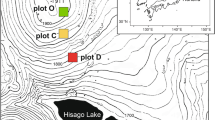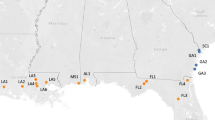Abstract
Rubus alceifolius Poiret (Rosaceae) was introduced to the island of Réunion in the southeastern Indian Ocean about 1850 and is now highly invasive. This bramble, native from southeastern Asia and Malaysia, has invaded a wide variety of habitats (lowland rainforest, mountain and submountain rainforest, Acacia heterophylla rainforest) from sea level to 1700 m. It is suspected to be monoclonal so, its remarkable success may be due in part to great phenotypic plasticity. On Réunion, bud, flower, fruit and seed production, the duration of the flowering period and the importance of the seed bank were found to be negatively correlated with elevation (50-1500 m a.s.l.). At a lowland site, fruit production in mature stands averaged between 30 and 80 fruits/m2 during 1999 and 2000. No fruit set occurred above 1100 m. This fruit production pattern was similar over two years. Although the number of leaves per unit area is similar along the whole gradient studied, decrease of fruit set in upland areas might be compensated for by an increase in vegetative growth. Temperature variation is very sharp along the elevation gradient and may control the fruit and the seed production. Fruit production allows establishment of new populations all around the island via bird dissemination. Once established, R. alceifolius maintains dense patches that can grow vegetatively. Our results may be relevant for eradication programs that should take into account variation in reproductive strategy in lowland vs. highland habitats.
Similar content being viewed by others
References
Amsellem L., Noyer J.L. and Hossaert-McKey M. 2001. Evidences for a switch in the reproductive biology of Rubus alceifolius (Rosaceae) towards apomixis, between its native range and its area of introduction. American Journal of Botany 88(12): 2243–2251.
Amsellem L., Pailler T., Noyer J.L. and Hossaert-McKey M. 2002. Characterisation of pseudogamous apospory in the reproductive biology of the invasive weed Rubus alceifolius (Rosaceae) in its area of introduction. Acta Botanica Gallica 149(2): 217–224.
Amsellem L., Noyer J.L., Le Bourgeois T. and Hossaert-Mckey M. 2000. Comparison of genetic diversity of the invasive weed Rubus alceifolius Poir., (Rosaceae) in its native range and in areas of introduction, using amplified fragment length polymorphism (AFLP) markers. Molecular Ecology 9: 443–455.
Bachelery P. 1981. Le Piton de la Fournaise (île de La Réunion), étude volcanique, structurale et pétrologique. PhD thesis, University of Clermont-Ferrand, France.
Baker H.G. 1965. Characteristics and modes of origin of weeds.. In: Baker H.G. and Stebbins G.L. (Eds.), The Genetics of Colonizing Species. Academic Press, New York, USA, pp. 147–69.
Baker H.G. 1974. The evolution of weeds. Annu. Rev. Ecol. Syst. 5: 1–24.
Barcelo A. 1996. Analyse des mécanismes hydrologiques sur domaine volcanique insulaire tropical à relief jeune. Apports à la connaissance du bilan hydrique. Massif du Piton de la Fournaise (île de La Réunion). PhD thesis, Université of Montpellier II, France.
Baret S. 1999. Etudes des modes de croissance et de propagation de la vigne marronne (Rubus alceifolius Poiret.) à La Réunion. Master report. Henri Poincarré University, Nancy, France.
Baret S., Nicolini E., Le Bourgeois T. and Strasberg D. 2003. Developmental patterns of the invasive bramble (Rubus alceifolius Poiret, Rosaceae) in Réunion island: an architectural and morphometric analysis. Annals of Botany 91(1): 39–48.
(île de La Réunion), leurs relations avec les structures du Bassin des Mascareignes. Océan Indien occidental. PhD thesis, scientific and medical University of Grenoble, France.
Cheke A.S. 1987. The ecology of the surviving native land-birds of Réunion. In: Diamond A.W. (Eds.), Studies of Mascarene Island birds. Cambridge University Press, Cambridge, UK, pp. 301-358.
Daehler C.C. 1998. The taxonomic distribution of invasive angiosperm plants: ecological insights and comparison to agricultural weeds. Biological Conservation 84: 167–180.
Gerlach Jr. J.D. 2001. Predicting invaders. Trends Ecol. Evol. 16: 545.
Gray A.J. 1986. Do invading species have definable genetic characteristics? Philos. Trans. R. Soc. London Ser. B,314: 655–672.
Huenneke L.F. and Vitousek P.M. 1990. Seedling and clonal recruitment of the invasive tree Psidium cattleianum: implications for management of native Hawaiian forests. Biological Conservation 53: 199–211.
Jordano P. 1982. Migrant birds are the main dispersers of blackberries in southern Spain. Oikos 38: 183–193.
Kolard C.S. and Lodge D.M. 2001. Progress in invasion biology: predicting invaders. Trends Ecol. Evol. 16: 199–204.
Lavergne C., Rameau J.C. and Figier J. 1999. The invasive woody weed Ligustrum robustum subsp. walkeri threatens native forests on La Réunion. Biological Invasions 1: 377–392.
Le Bourgeois T. 1998. Etude sur la Lutte Biologique contre la peste végétale Rubus alceifolius à La Réunion: étape n°1 Bibliographie. CIRAD, Montpellier, France.
Le Bourgeois T. 2001. Etude sur la lutte biologique contre la peste végétale Rubus alceifolius à la Réunion, Rapport final. CIRAD, Montpellier, France.
Lloyd D.G. 1980. Sexual strategies in plants. I. An hypothesis of serial adjustment of maternal investment during one reproductive session. New Phytologist 56: 69–80.
Lorence D.H. and Sussman R.W. 1986. Exotic species invasion into Mauritius wet forest remnants. Journal of Tropical Ecology 2: 147–162.
Lorence D.H. and Sussman R.W. 1988. Diversity, density and invasion in a Mauritius wet forest. Monographs and systematics of the Missouri Botanical Garden 25: 187–204.
Macdonald I.A.W., Thébaud C., Strahm W.A. and Strasberg D. 1991. Effects of alien plant invasions on native vegetation remnants on La Réunion (Mascarene Islands, Indian Ocean). Environmental Conservation 18(1): 51–61.
Mandon-Dalger I. 2002. Sélection de l'habitat et dynamique d'invasion d'un oiseau introduit, Pycnonotus jocosus, à la Réunion. PhD thesis, University of Rennes 1, France.
Marks P.L. 1983. On the origin of field plants of the northeastern United States. American Naturalist 122: 210–228.
Maurice S. and Strasberg D. 1999. Etude sur la lutte biologique contre la peste végétale Rubus alceifolius à la Réunion. Rapport annuel d'activité 1999. CIRAD, Montpellier, France.
Nybom H. 1988. Apomixis versus sexuality in blackberries (Rubus subgen. Rubus, Rosaceae). Plant Syst. Evol. 160: 207–218.
Nybom H. 1995. Evaluation of interspecific crossing experiments in facultative apomict blackberries (Rubus subgen. Rubus) using DNA fingerprinting. Hereditas 122: 57–65.
Phelouzat R. 1982. Croissance et auto entretien d'une population de Ronce (Rubus fruticosus L.) dans des conditions d'une hêtraie. Bull. Soc. Bot. Fr. Lettres bot. 129(3): 201–212.
Pyšek P. 1997. Clonality and plant invasions: can a trait make a difference?.. In: de Kroon H. and van Groenendael J. (Eds.), The ecology and evolution of clonal plants. Backhuys Publishers, Leiden, Netherlands, pp. 405-427.
Rejmánek M. and Reichard S. 2001. Predicting invaders. Trends Ecol. Evol. 16: 545–546.
Robert R. 1986. Climat et hydrologie de la Réunion, étude typologique, étude régionale de l'alimentation et de l'écoulement. Thèse d'Etat, Université de Montpellier III, France.
Sakai A.K., Allendorf F.W., Holt J.S., Lodge D.M., Molofsky J., With K.A., Baughman S., Cabin R.J., Cohen J.E., Ellstrand N.C., McCauley D.E., O'Neil P., Parker I.M., Thompson J.N. and Weller S.G. 2001. The population biology of invasive species. Annu. Rev. Ecol. Syst. 32: 305–332.
Simberloff D. 2000. Global climate change and introduced species in United States forests. The Science of the Total Environment 262: 253–261.
Sol D. 2001. Predicting invaders. Trends Ecol. Evol. 16: 544.
Stephenson A.G. 1981. Flower and fruit abortion: proximate causes and ultimate functions. Annual Review of Ecology and Systematics 12: 253–279.
Strasberg D. 1994. Dynamique des forêts tropicales de l'île de la Réunion, processus d'invasion et de régénération sur les coulées volcaniques. PhD thesis, Université of Montpellier II, France.
Thébaud C. 1989. Contribution à l'étude des plantes étrangères envahissantes à l'île de la Réunion. Rapport, Conseil Régional de la Réunion, France.
Thompson M.M. 1997. Survey of chromosome numbers in Rubus (Rosaceae: Rosideae). Ann. Miss. Bot. Gard. 84: 128–164.
Vaughan R.E. and Wiehe P.O. 1941. Studies on the vegetation of Mauritius. III. Journal of Ecology 29: 127–160.
Vitousek P. 1988. Diversity and biological invasions on oceanic islands. In: Wilson E.O. and Peter F.M. (Eds.), Biodiversity. Nat. Academy Press, Washington, USA, pp. 181-189.
Author information
Authors and Affiliations
Corresponding author
Rights and permissions
About this article
Cite this article
Baret, S., Maurice, S., Le Bourgeois, T. et al. Altitudinal variation in fertility and vegetative growth in the invasive plant Rubus alceifolius Poiret (Rosaceae), on Réunion island.. Plant Ecology 172, 265 –273 (2004). https://doi.org/10.1023/B:VEGE.0000026345.67250.d2
Issue Date:
DOI: https://doi.org/10.1023/B:VEGE.0000026345.67250.d2




